本文由 MARC FORNES / THEVERYMANY 授权mooool发表,欢迎转发,禁止以mooool编辑版本转载。
Thanks MARC FORNES / THEVERYMANY for authorizing the publication of the project on mooool, Text description provided by MARC FORNES / THEVERYMANY.
MARC FORNES / THEVERYMANY:德克萨斯州Lubbock德州理工大学荣誉宿舍庭院,这个为师生们提供遮荫通道的风态雨棚构筑Zephyr展亭,成为了无数人流汇聚的社交点,其结状中心延伸而出的凌空悬臂,既在校园小路上充当了标志信号,又为人们提供了庇护作用。
MARC FORNES / THEVERYMANY:Zephyr Pavilion, a windswept canopy, offers a shaded passage through the courtyard of the Honors Residence Hall at Texas Tech University in Lubbock, Texas. The pavilion serves as a social anchor at the convergence of countless flows. Dueling cantilevers extend from a knot-like center, offering both a signal and a sheltering experience along the campus path.
这个温柔的巨物是我们通过精细的计算程序精心设计而成的图形化结构。其四个密集的条纹柱扩展成桥状弧形,波浪形翅膀和开放的环状柱,构成了此处的天空视角。校园道路在此处汇集并穿过展亭,其形态的起伏也受到空间中各种路径的影响,倾斜圆柱汇聚而成的拱形曲线和沉静精致的体量,为校园建筑和天空打开了新的视野。其弯曲流线轨迹形成的中空结构,构成了一个可与同学见面、边喝咖啡边学习或在去上课的路上散步的休闲空间。
This gentle giant is a highly curated scheme of computationally finessed protocols informing a graphically rich structural skin. Four densely striped columns expand into bridging arcs, undulating wings and open looped columns that define oculi to the sky. Zephyr Pavillion embraces cross-campus traffic, pulling paths into and through its voluminous spaces. The rise and fall of the form is influenced by the various traffic paths through the space. Arches curve out of the convergence of canted columns and the quietly sophisticated body opens new views onto the campus architecture, and to the sky above. The hollow-bodied structure harnesses flowing trajectories in diagonalized stripes of intense curvature which shear out from an articulated base and provide a space to meet with fellow students, study while enjoying a coffee or to simply stroll through on the way to class.
长度 At Length
这个位于大学生日常生活轴上的风态景亭Zephyr,激活了德克萨斯理工大学这条穿过荣誉宿舍楼的庭院的荫蔽通道。新的永久性建筑结构在繁华的校园社区中形成了一个社交汇点,这个开放的庭院成为了连接无数道路的纽带,将日常的漫步体验提升至了城市通道般的运动体验。其形态的起伏也受到空间中各种路径的影响,倾斜圆柱汇聚而成的拱形曲线和沉静精致的体量,为校园建筑和天空打开了新的视野。
Situated on an active axis of collegiate life, Zephyr Pavilion, a windswept canopy, activates a shaded passage through the courtyard of the Honors Residence Hall at Texas Tech University in Lubbock, Texas. The new permanent architectural structure defines a social anchor in the bustling campus community. An open courtyard becomes a nexus for the merging of innumerable paths. Zephyr elevates a daily stroll into an experiential motion through an urban passage. The rise and fall of the form is influenced by the various traffic paths through the space. Arches curve out of the convergence of canted columns and the quietly sophisticated body opens new views onto the campus architecture, and to the sky above.
渐进式装配(磨滑,拼接) PROGRESSIVE ASSEMBLY (ground up, puzzle up)
Zephyr根据THEVERYMANY的标志性建设方式建造而成——渐进装配:将每一个结构,分解为它的组成部分,即一系列相互联系的结构条纹。这个条纹的基本单位,是完成根据最终结构的色彩、形式和完整性而计算得出的图案。德州理工大学独特的条件造就了这种由紧密缠绕的斜纹构成的形状,其受控的褶皱形成连续性的切向曲率,从而在角的几何基础上变得更加平滑。这种渐进的装配方式,可保证每一个部件都与最后一个部件的位置相吻合,并且不需要任何额外的构件。铝制条纹结构顺着圆柱向上延伸,形成一个复杂的顶篷。渐进式装配在结构上要求有非常精确的施工顺序:先磨滑,再拼接。预先组装起更大的模块,并不是一个明智的选择,因为每增加一条条纹,整个模块就会变得更具刚性(坚硬),如果没有给定的公差,这些大模块就不能一起松懈下来进行调整,还要重新引进重型起重设备帮助安装。零件的逐步连接同时也是为下一个零件的整体形式做好准备,如果将错误的零件强行按顺序摆放,它其实是起不到作用的,必须要一点一点,一步一步地完成整个工作,因此,作为我们塑造双曲面的主要驱动力,时间也是装配过程的一个重要组成部分。
Zephyr relies on the hallmark construction process of THEVERYMANY: Progressive Assembly. Each structure, broken down to its component parts, is a series of interreliant StructuralStripes. At this base unit of the stripe, computationally derived patterns are fully ingrained into the coloration, form, and integrity of the resulting structure. The unique conditions at Texas Tech produced a form composed of tightly coiled, angled stripes. Controlled folds produce tangential continuity of the curvature, which generates gentle movements broadly across the angular underlying geometry. As a progressive assembly, each part fits into the position of the last and builds up without any added molding. Structural aluminum stripes climb the intensive curvature of the column and open into surface condition, generating a complex canopy overhead. Progressive assembly requires a very precise sequence in construction; ground up, puzzled up. Pre-assembly of larger blocks is not an option since with every additional stripe the overall module becomes more rigid. With no given tolerances, large sections cannot be eased together. It would also require the re-introduction of heavy lifting equipment. Progressive connection of parts primes the overall form for the next piece. If a part is forced into place out of sequence it will not work. Little by little, one part at a time, the work will come together. Consequently, timing has become a vital component of the assembly process as our primary driver for shaping a double-curved surface.
▼Zephyr装置表面细节 Zephyr details
对角编织 DIAGONALYZED WEAVE
工作室最初发明的计算拟定程序,允许线形条纹展示双曲面的双层外壳。条纹系统形成的统一、高效的体系结构,有时根据系统的位置和方向,可能会出现这样的问题,即在各层之间形成不需要的层次结构:一层主要用作连接器或联合器,另一层则承载了更多的承重。在Zephyr中,系统被对角化——旋转45度——以便两层都能同时发挥承重和连接功能。在应力分布均匀的情况下,可以对层的厚度进行优化。材料的厚度不再仅仅取决于恒载和风载,而是取决于更多的环境因素,比如点载和破坏的可能性。Zephyr中结构条纹的横向图案可满足其跨度和高度,且不需要任何增厚、内部结构或临时脚手架。
The studio initially invented computational protocols allowing linear stripes to describe a doubly curved, two-layered skin. The stripe system crystallized into a unified, efficient architectonic system. Sometimes, depending on the location and orientation of the system, an issue can arise in which an unwanted hierarchy is formed between the layers: one layer carries more downloads when the other mostly acts as a connector or unifier. In Zephyr, the system was diagonalized – rotated 45 degrees – in order for both layers to carry downloads and act as connectors simultaneously. With the stressors distributed equally, the layers can become optimized in terms of thickness. Material thickness is no longer solely based on dead loads and wind loads, and now responds to situational factors like point load and potential for vandalism. In Zephyr, the cross-directional patterning of structural stripes allows the formation of a span and height without any thickening, internal structure or temporary scaffolding.
▼对装置的计算拟定 Computational protocols for installation
结构性 A STRUCTURAL REPERTOIRE
Zephyr是一种部分依赖于物理原理和高度组织的几何运动来驱动其设计的结构形式。在我们过去30个项目的设计研究中,工作室的结构条纹原则在定义最佳厚度方面达到了一个暂时的顶点,结构不再是这种优化的主要驱动力。超薄结构几何的扩展系列建立的实验推动了这种组成形式的回归,而这项作品正推开了其新正式行动的大门,如果仅仅基于对结构的追求,这些在结构上并不是最优的。其开放的环形柱,漏斗状的桥梁,两等分的折线和流线型的锁边定义了一系列结构类型,形成了Zephyr展馆的明显曲率。这种水平的压缩条纹,能承载更多负荷的外立面,使得首次生产自支撑悬臂成为可能。Zephyr的突出悬臂作为一个悬臂外壳,它既不是典型的受压外壳结构,也不是典型的悬臂梁,仅通过其结构表皮的层叠和微妙褶皱延展在空中。当外臂从中心延伸至完全显露在中空时,由此产生的空间模糊了室内、室外的界限。
Zephyr is a form partially reliant on physics-based principles and highly curated geometrical moves to drive its design. In design research across the last 30 projects, the studio’s principle of Structural Stripes have reached a temporary apex in defining optimum thickness. Structure is no longer the main driver for this optimization. The extended series of built experiments in ultra-thin structural geometry has propelled a return to form as composition. The work is opening itself to new formal moves that would have not been structurally optimal if based on the quest for structure alone. Open looped columns, funneled bridges, a bisecting creased spine and streamlined locked edges define the beginning of a repertoire of structural typologies that produce the intensive curvature on Zephyr Pavilion. At this level of compressed striping, the skin is able to carry more loads, making it possible for the first time to produce self- supporting cantilevers. Zephyr’s projecting wings are held aloft solely by the layering and subtle folds of its structural skin, as a cantilever-shell, that is neither the typical compressive shell structure loaded at its edges, nor the typical beam cantilever. The resulting space complicates the understanding of interior and exterior when the enclosure finally reveals itself as totally hollow from the projected ends.
▼流线型结构,严密的条纹组织 Streamlined structure, tight stripe organization
自由形态:发现新的组合形式 FREE(D) FORM: COMPOSED FORM FINDING
Zephyr Pavilion是一个在我们的作品中引入自由形式原则的结构,将其从基本的形式约束中释放出来。您可以从一个结构拓扑列表中取样、组合和管理,以生成真正的环境惟一的东西。Zephyr是由精心组合的网格拓扑样本正式导出的,每个样本一旦在计算上放松,就可以在整个体系结构系统中创建有效的结构时刻。将拓扑组合与局部形式查找相结合,会创造更大的自由度,同时仍然能保证处理结构的效率,而不是一个普遍应用的表单查找过程,当然它也可能有一定的限制和可预测性。这种解决问题的方法能够将壳体结构和悬臂梁组合成一个完整的结构表皮。一条又一条的条纹,将结构打开,在流动式的顶棚下,和中空的结构内部创造大量的空间。穿过柱廊或顶棚的风洞,仿佛在校园中留下了一段乘着西风的宁静时光。
Zephyr Pavilion is a structure that introduces the principle of Free(d) Form in our body of work. Released from essential form finding constraints, one can sample, combine and curate from a structural topology repertoire to produce something truly environmentally unique. Zephyr is formally derived from carefully composed mesh topology samples. Each sample, once computationally relaxed, is known to create efficient structural moments within the overall architectural system. Rather than a universally applied form finding process, which can be somewhat limiting and predictable, topological composition combined with local form finding allows for greater freedom while still addressing structural efficiency. Such an approach to problem solving enables the combination of a shell structure and cantilevers into one integrated structural skin. Supported stripe to stripe, the work is opened to create spaces of volume not only under the flowing canopy but within the hollow body itself. Inside a wind tunnel, through a colonnade or under a canopy, the campus community will find a slowed moment of peace, as if carried away by a pleasant westerly wind.
▼穿走在内部空间中 Walk through the interior space
项目名称:和风凉亭
客户:德克萨斯理工大学
尺寸:18 ‘ H x48 ‘ W x13 ‘ D
材料:两层3mm铝线
直线切割距离:7400米
零件数量:2.343
铆钉数量:59,216
设计/建造:MARC FORNES / THEVERYMANY
摄影:NAARO
Project name: hefeng pavilion
Client: Texas Tech University
Dimensions: 18’ H x 48’ W x 13’ D
Material: two layers of 3mm aluminum
Linear Cut Distance: 7,400 meters
Number of Parts: 2.343
Number of Rivets: 59,216
Design/Build: MARC FORNES / THEVERYMANY
Photography: NAARO
更多 Read more about: MARC FORNES / THEVERYMANY



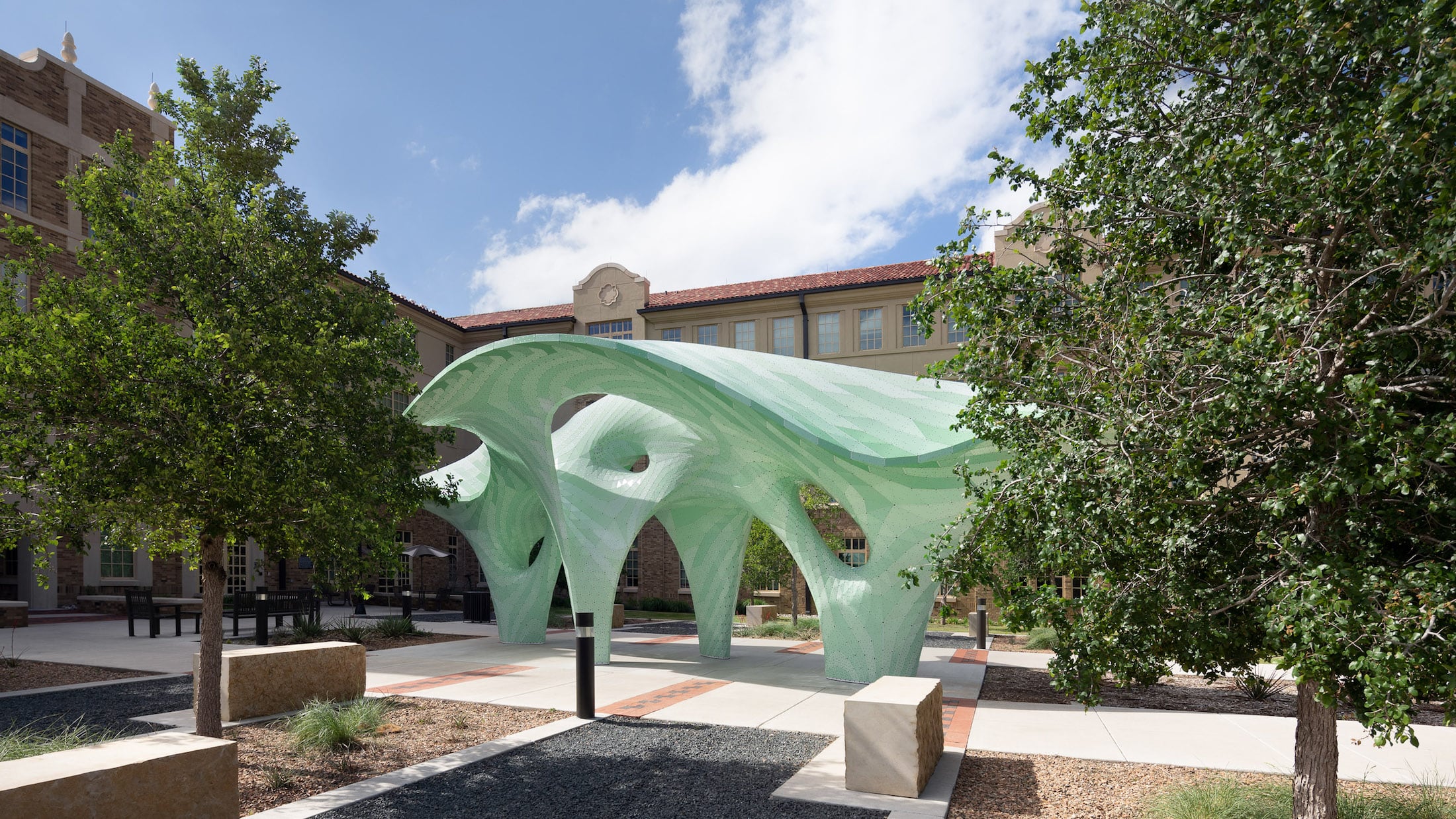
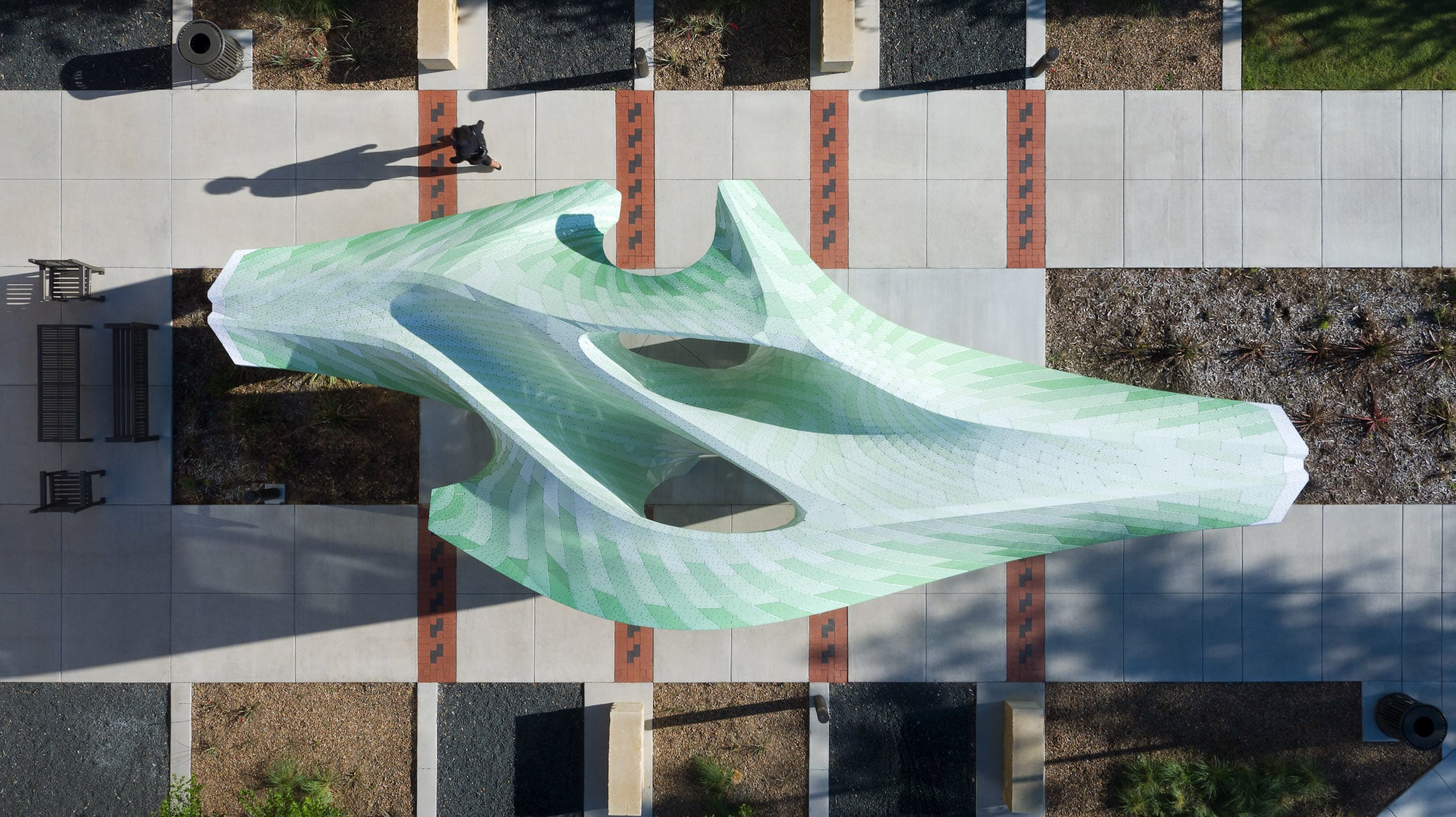


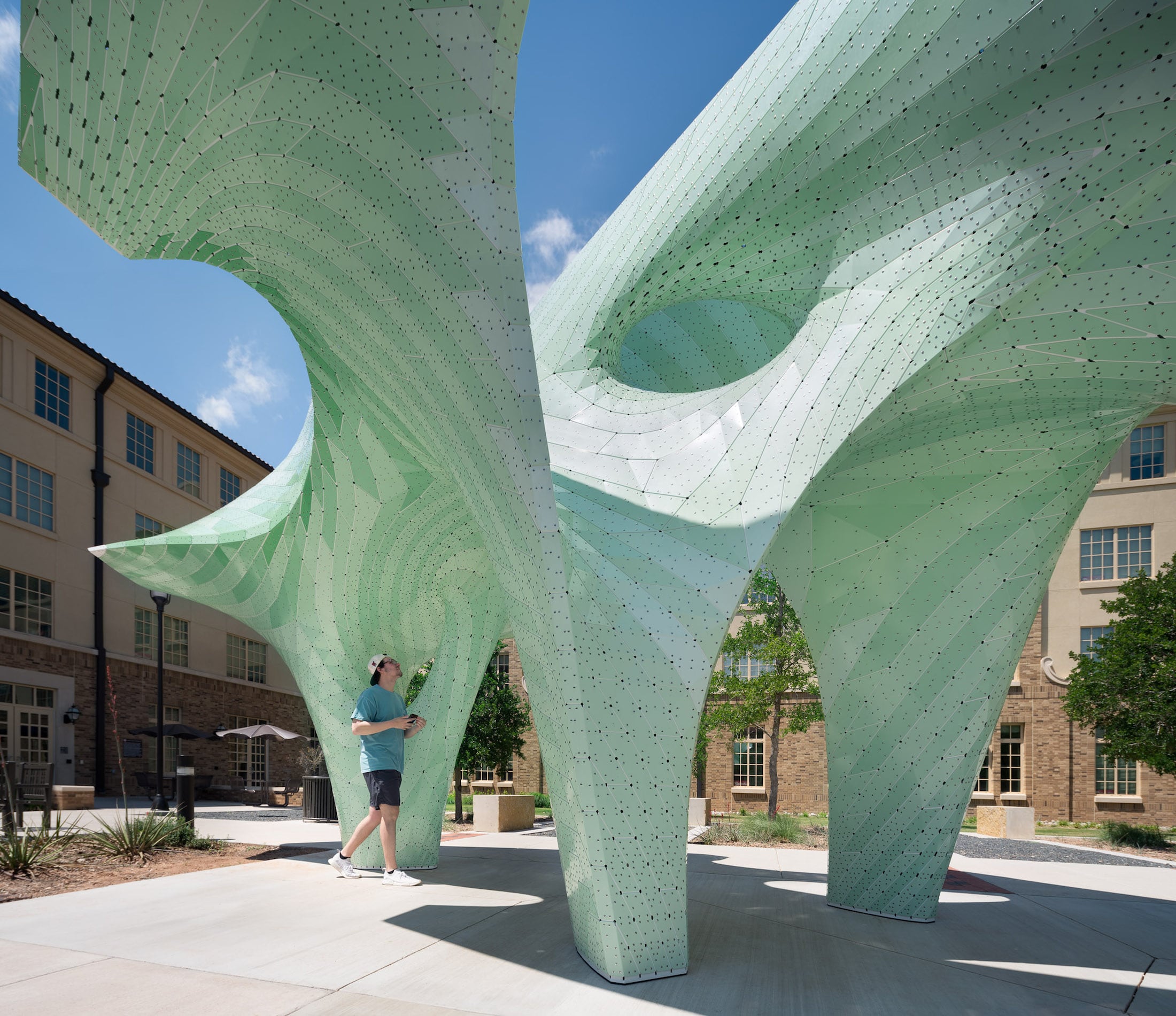
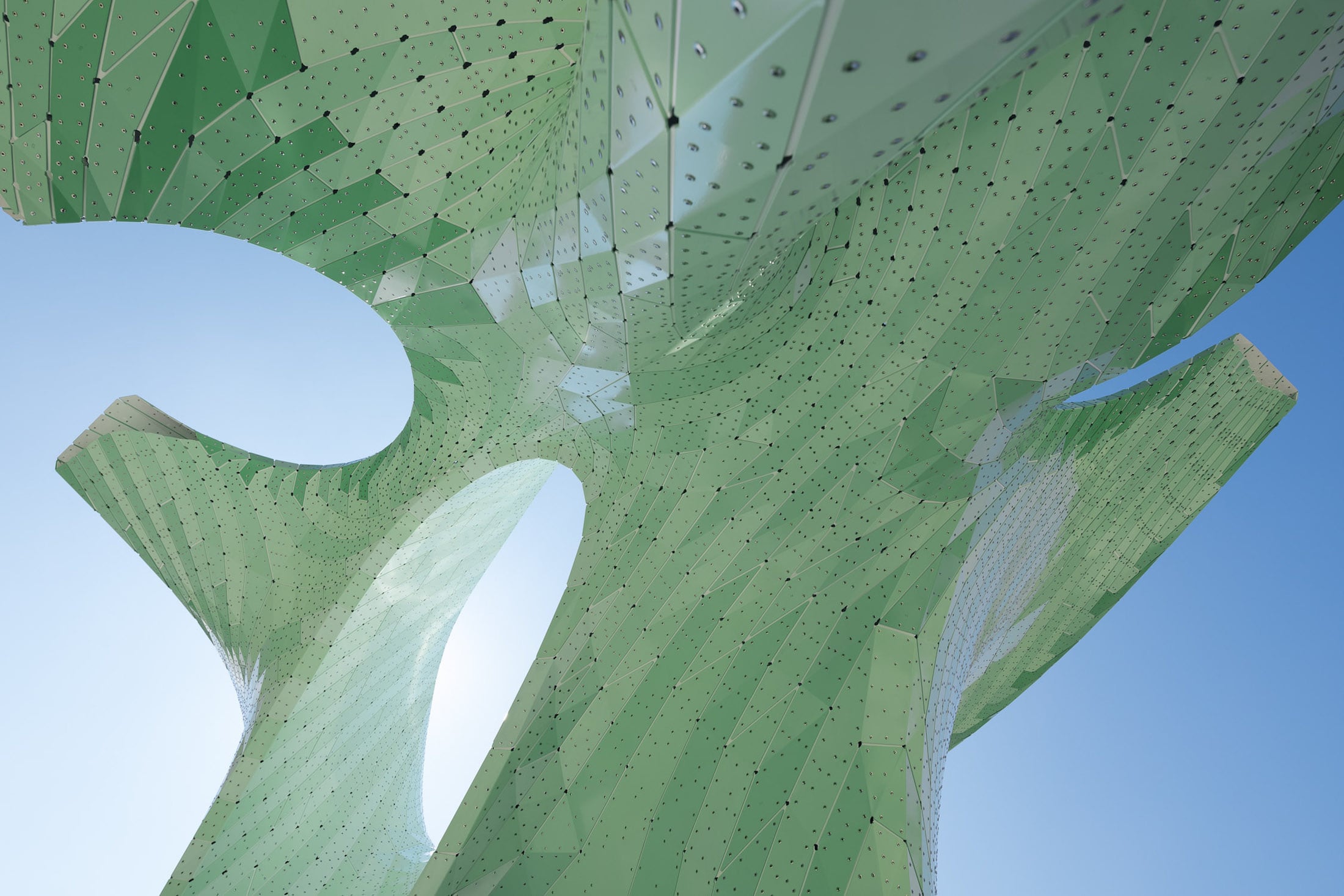

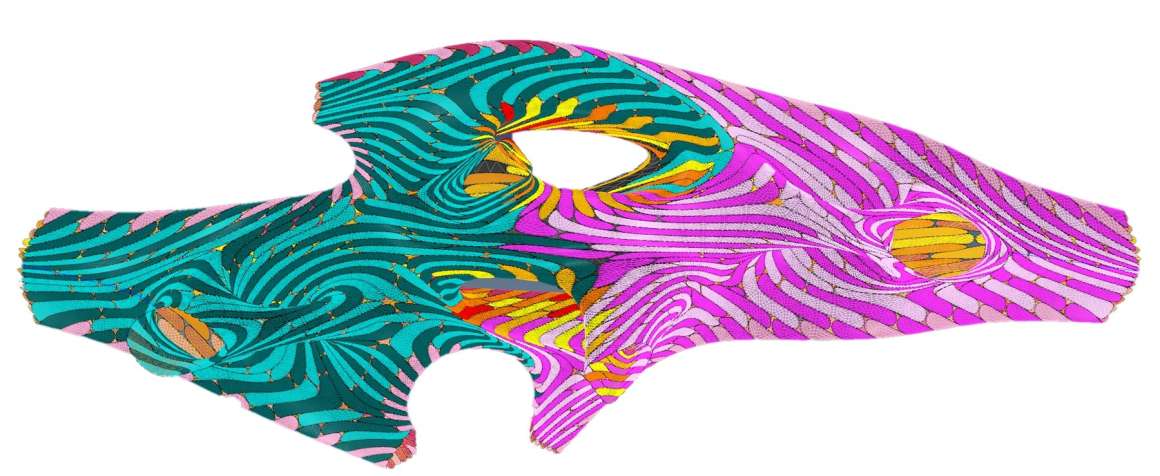


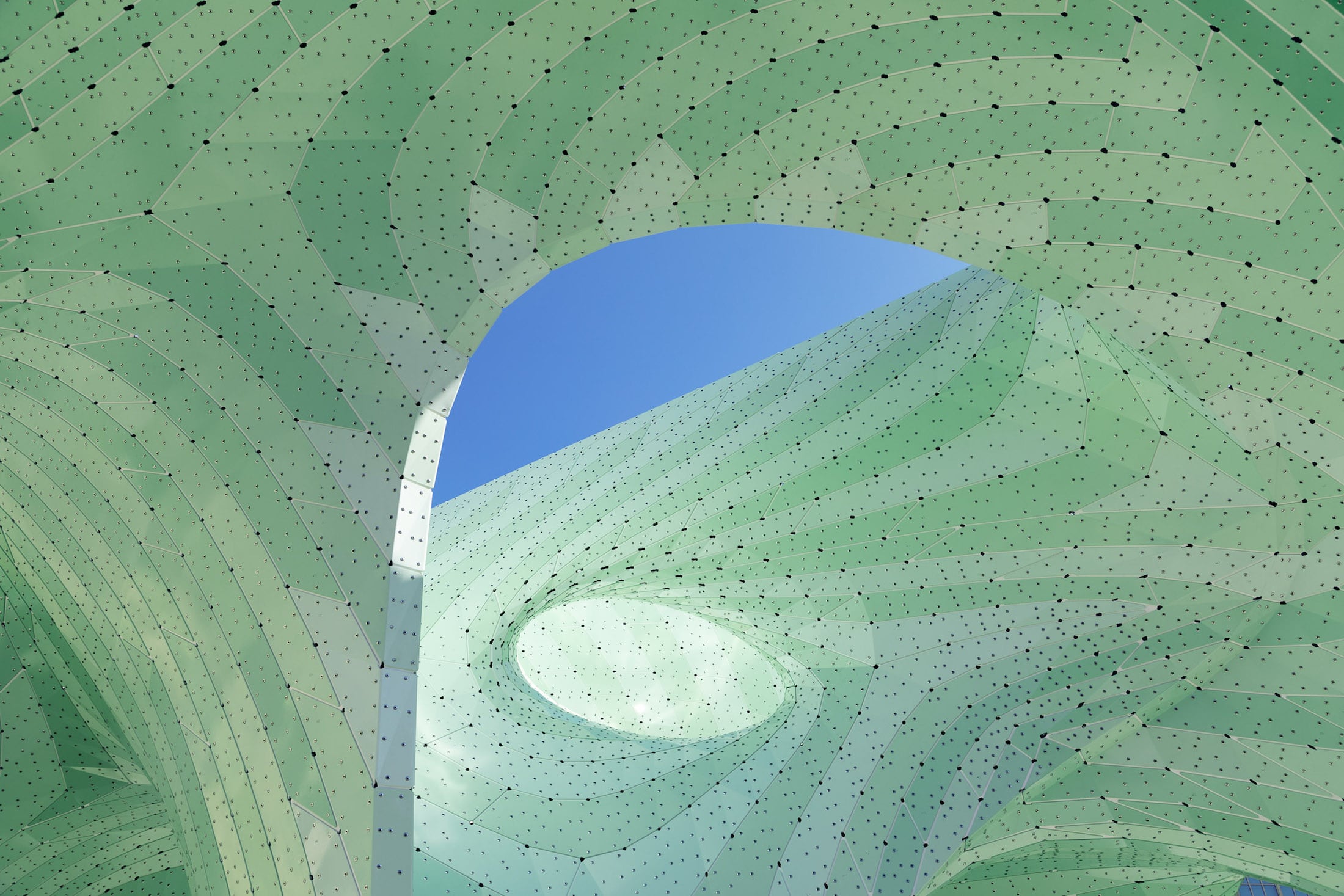
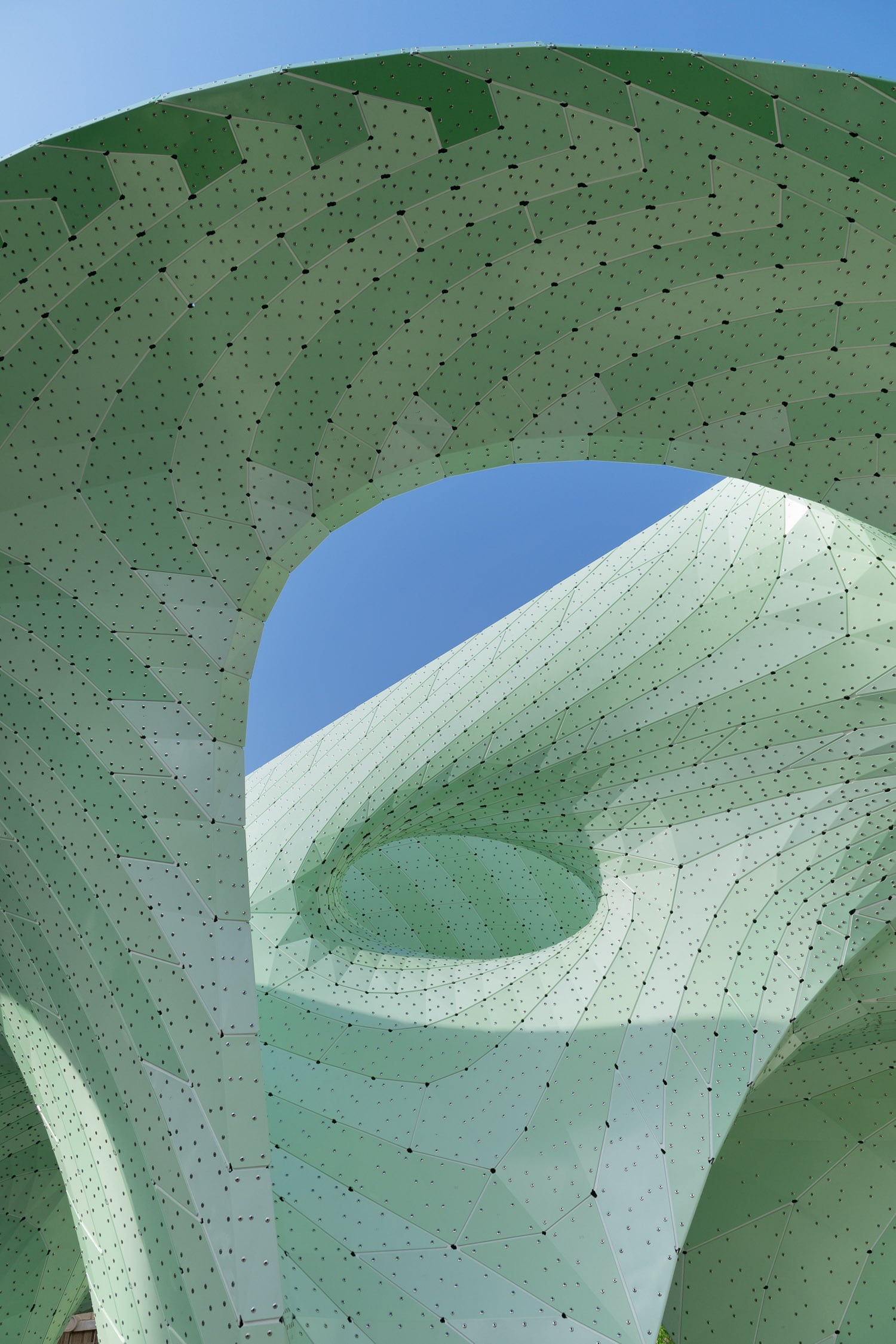



0 Comments